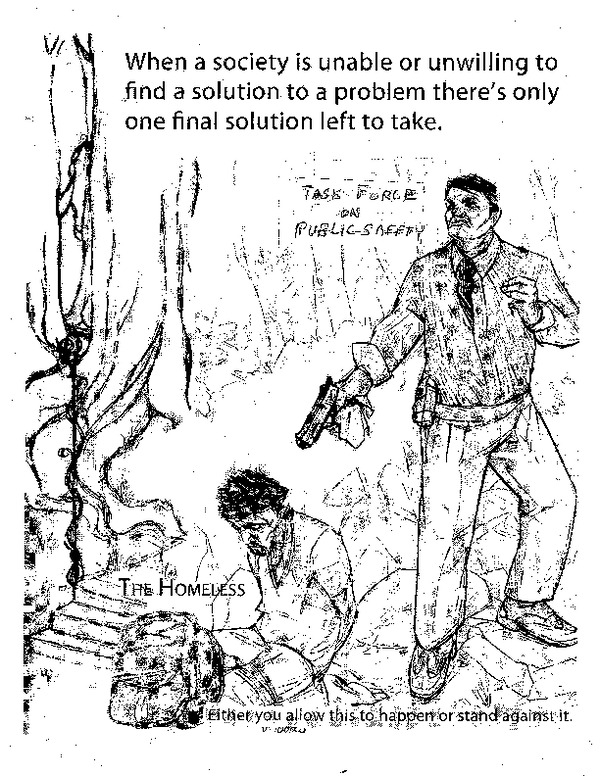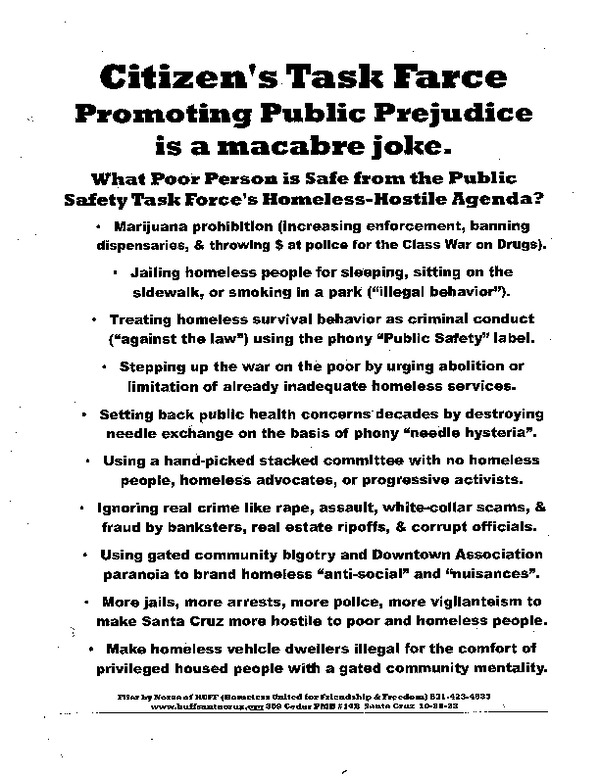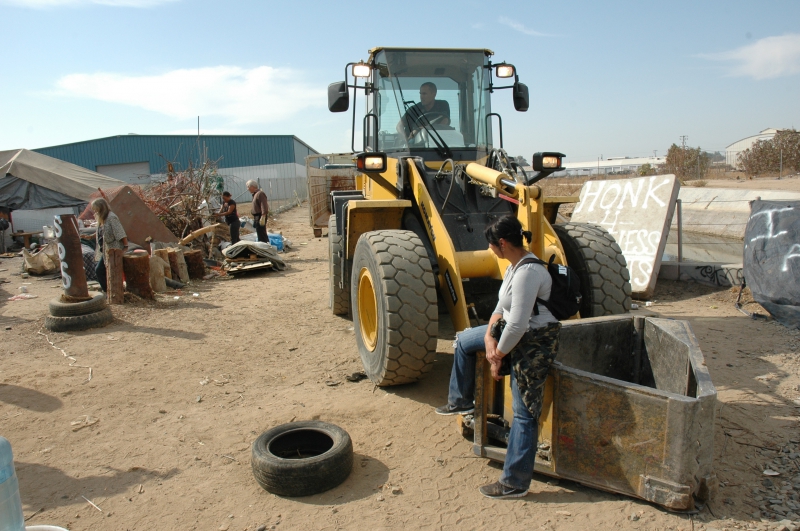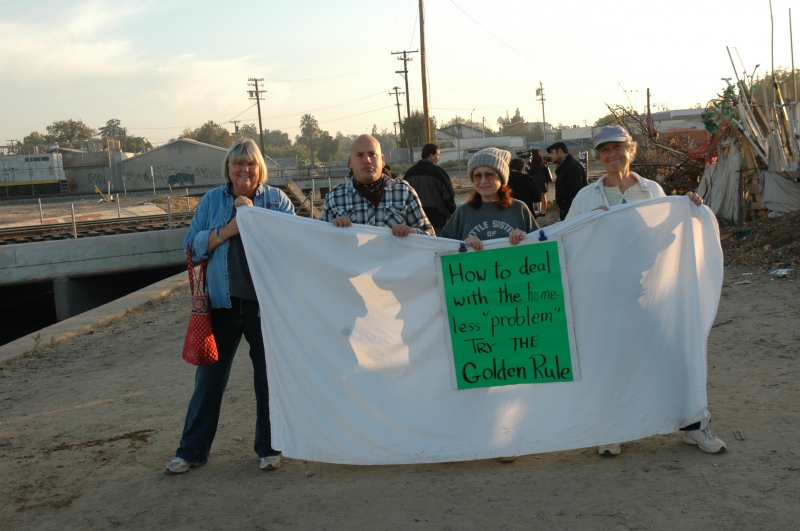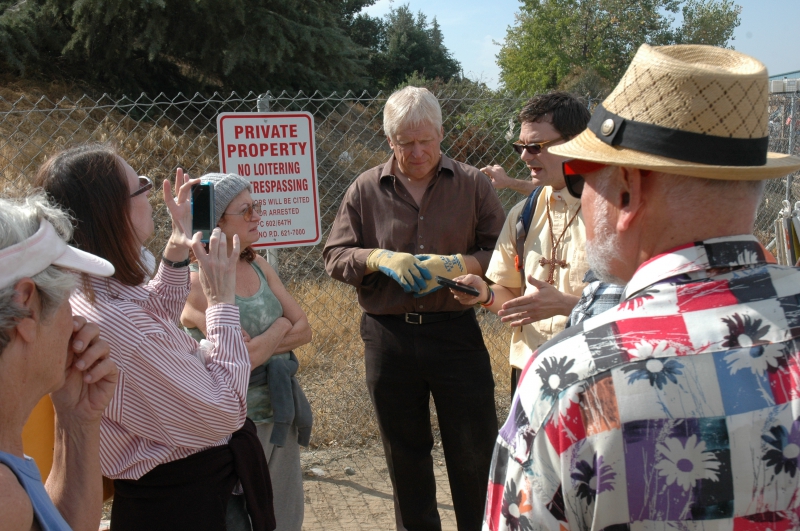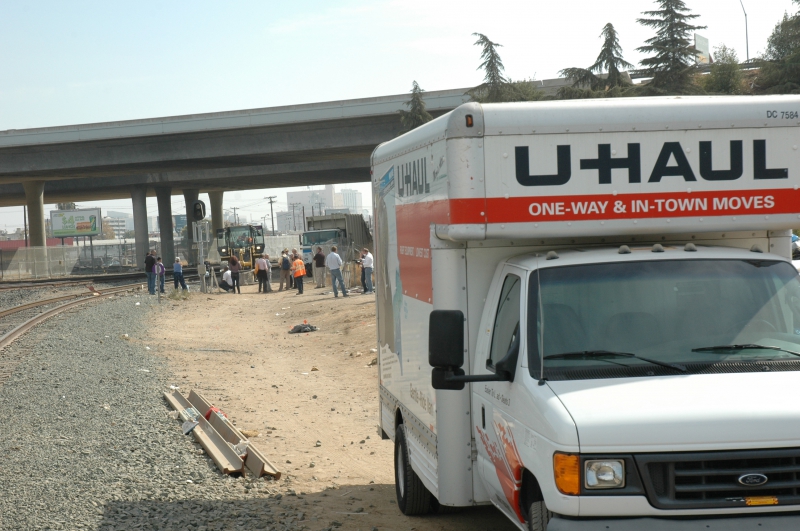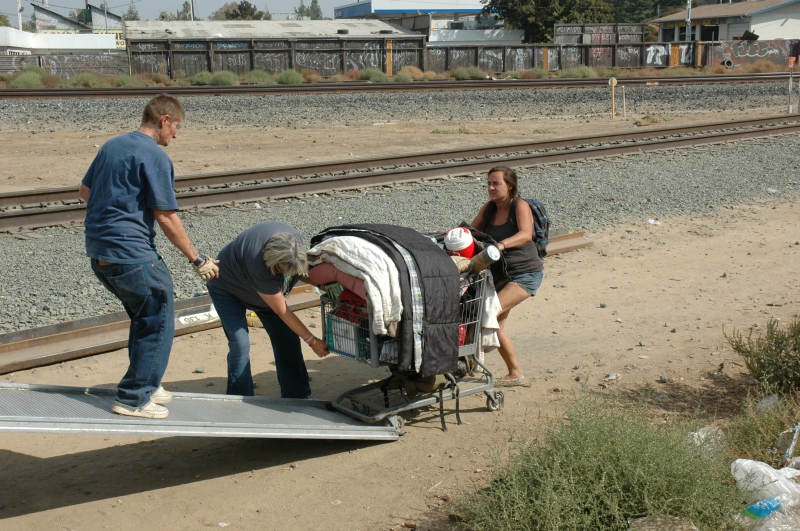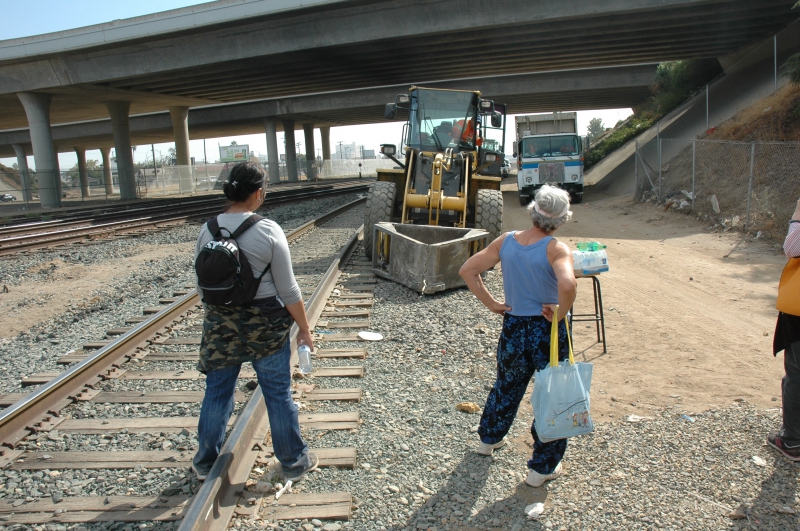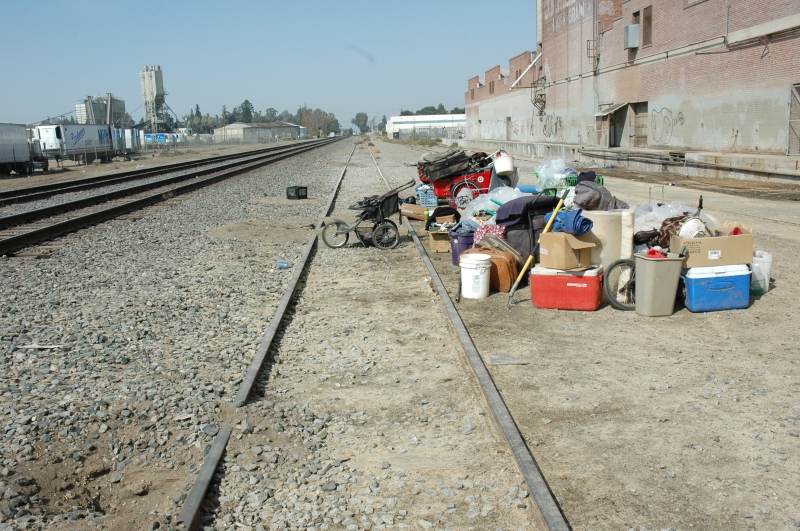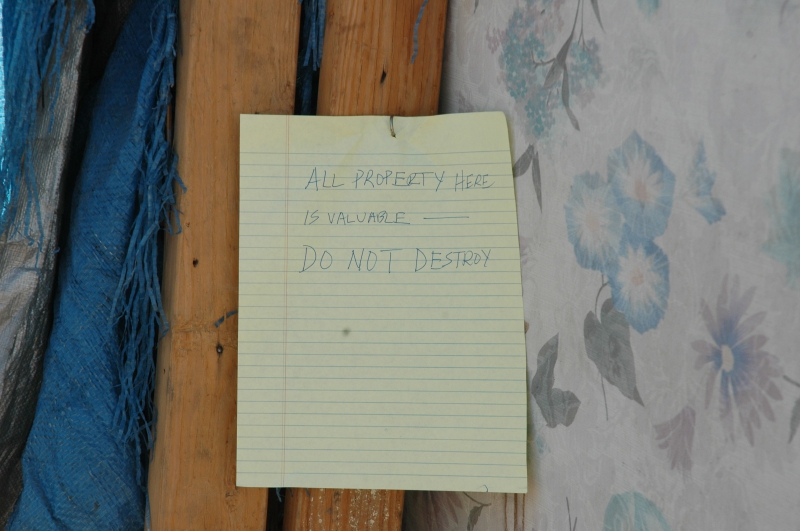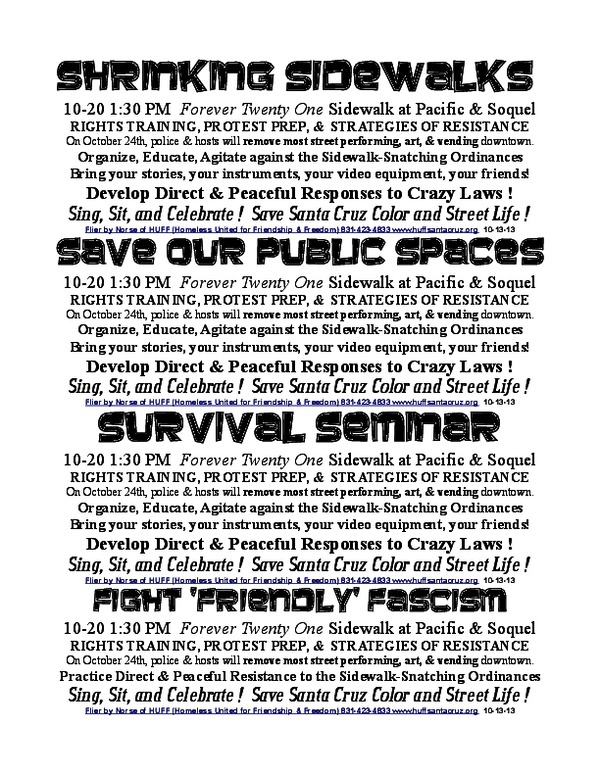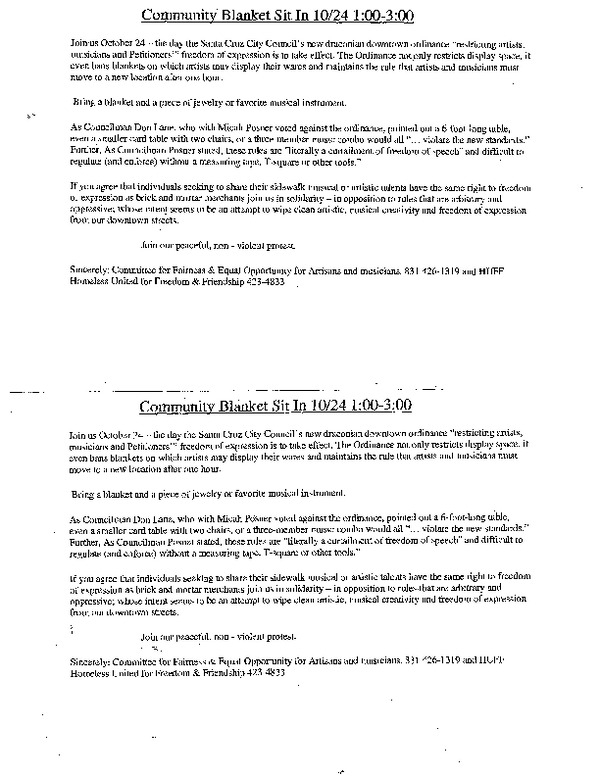NOTES BY NORSE: The Santa Cruz City Council sold out its two supposedly “rent-controlled in perpetuity” Mobile Home Parks (De Anza and Clearview Court) a decade ago under similar gentrification pressure. (The excuse was “costly lawsuits”). Now those living there have no equity in their homes because when they die or leave, rents will move from affordable to astronomical.
Palo Alto’s recent ban on Vehicle Habitation is another nail in the Gated Community Fence plague that is currently sweeping the country. In Santa Cruz, Mayor Bryant’s hand-picked coterie of bigot-enablers, the Citizens Task Force on Public Safety has come up with preliminary recommendations explicitly designed to drive homeless people away and intensify the criminalization process here (See
http://www.cityofsantacruz.com/Modules/ShowDocument.aspx?documentid=34511 ). For those who want to witness this obscenity in person, go to the Community Room of the police station today (10-16) at
6 PM. Watch Fred Keeley give his blessing to this toxic nonsense.
HUFF meets today to plan protests against the Shrinking Sidewalks (
11 AM Sub Rosa at 703 Pacific in Santa Cruz). The Street Performers Guild meets 11 AM Saturday 10-19 at India Joze restaurant at 418 Front St.. Sunday’s follow-up Tour of Shame is slated for the next day 1 PM Sunday 10-20 in front of Forever Twenty-One at Soquel and Pacific. Speak Out at City Council
Tuesday 5 PM 10-22 809 Center St. The ordinances and possible CD protests begin
October 24th.
Silicon Valley Trailer Park Residents Fight To Stay
Sunny Palo Alto, Calif., is awash in multimillion-dollar homes, luxury Tesla electric cars and other financial fruits from a digital revolution the city helped spark. The Silicon Valley city is home to Stanford University, at least eight billionaires, and one mobile home park.
Now, Buena Vista Mobile Home Park — one of the largest and one of the few remaining affordable housing options here — is threatened with closure. The owners want to to a developer who plans to build luxury apartments for the high-tech corridor’s growing workforce. The park’s low-income, mostly Latino residents are fighting to stay in their community and to keep their kids in one of California’s best school districts.
The fight shows the less-publicized underbelly of Silicon Valley’s incredible successes: unequal access to education, and the marginalization of some low-income workers.
A Good Education
“Most of us don’t really know where we’d go” if the park closed, says 28-year-old Erika Escalante, who grew up at Buena Vista and now lives in a mobile home there with her husband and 6-year-old son. “With rents in Palo Alto, it’s just impossible,” she says.
Quality public education is the main reason many of the park’s residents are fighting to stay. The Palo Alto schools among more than 1,000 districts in the state, and test scores for all ethnic groups have regularly exceeded statewide averages.
Escalante was the first in her family to graduate from college. Her sister and brother are now following her lead. Escalante’s dad worked as a janitor. She says he moved the family to Buena Vista largely because of the schools.
“He felt like we were getting the best education that he could possibly offer to us,” Escalante says. “I mean, we know that historically Hispanics are kind of disadvantaged. There’s that big education gap. And to be able to have access to that education, I mean, you can’t put a price there. We want to be able to succeed, you know, kind of like that American dream. Education is a big part of that.”
An Airstream To Call Home
Buena Vista is home to more than 400 predominantly low-income residents, more than 80 percent of them Latino.
Ringed with a jumble of potted plants, a silver ’70s-era Airstream trailer has been home to Jennifer Tello for most of her 12 years.
“My mom works cleaning houses, and my dad works construction,” she says. Jennifer’s mom is busy getting food for her baby sister before heading off to work. Jennifer says her parents struggled to find a place in the Bay Area that’s safe, affordable and has quality schools.
“They’re really good schools. My mom works really hard, and so does my dad. Sometimes they don’t have enough time to spend with us. I’m really happy that they’re really hard working. And they encourage me to work hard, so I [could] have a better job,” she says.
The park’s owners, Toufic and Eva Jisser, have petitioned the city of Palo Alto to close shop. They want to sell the land to Prometheus Real Estate Group, which wants to build 180 luxury apartments on the site. “My client has a constitutional right to exit the rental business,” says Margaret Ecker Nanda, the owners’ lawyer. Prometheus officials declined to comment.
Erika Escalante is a program coordinator for the Palo Alto Medical Foundation. She grew up in the Buena Vista Mobile Home Park and now lives there with her husband and 6-year-old son, Andre Xavier Bracamontes.
Eric Westervelt/NPR
The Value Of Diversity
Jennifer Tello attends a nearby middle school. “I don’t want to move and start all over and find new friends,” she says.
The PTA, the school board, and some parents have taken action to back the park’s residents. They’ve offered supportive resolutions, organizing space, and their time. Nancy Krop, a civil rights attorney, is one of those parents. She says diversity, fairness and justice are at stake.
“I want every child to have the opportunity that my son’s going to have — and that I had,” Krop says. These kids at Buena Vista “want the world, and know they need a Palo Alto education to get it.”
Krop says she was attending a City Council meeting when one Buena Vista mother spoke up. “She mentioned that she made a living cleaning other peoples’ houses. And she asked the City Council to please allow her family to keep their home at the mobile home park because she felt that if her daughter went through the Palo Alto schools, her daughter would not grow up to clean other peoples’ homes,” says Krop. “I was really struck by that.”
Krop’s fifth-grade son attends nearby Barron Park Elementary, where 35 percent of the students are Latino and about half the students are learning English. She says the benefits of that diversity are key for her family in a city that is incredibly affluent and still mostly white.
“My son has gone on play dates to homes where he found out his friend didn’t have a bedroom. His friend sleeps on a couch. He didn’t even know that that was how some kids grow up. You learn what they don’t have; you learn the richness of what they do have too — the strength of their community and culture and heritage,” she says.
Trying To Stop The Sale
The residents are asking the city to help stop the sale. They point out that city planning documents list the mobile home park as a key source of affordable housing and “encourages its preservation.” But ultimately, that may not mean much legally. Palo Alto city attorneys say the mobile home park is not counted as part of a regional affordable housing plan required by the state.
The city has twice rejected the owners’ application to close the park, largely due to incomplete details in its relocation benefits package. “There is recognition of the desire to preserve the park,” says city spokeswoman Claudia Keith. But with soaring private property values in Silicon Valley, she says there may be little the city can do. The park’s residents can appeal any final decision the city makes to an independent hearing officer.
The Buena Vista residents’ group, with help from legal aid and affordable housing organizations, offered to buy the property for $14.5 million. The owners rejected that offer.
The owners’ attorney Margaret Nanda says her client has every right to cash in on booming property values and retire. The owner was offered more than $30 million for the 4.5-acre lot. “He is not a social agency or a nonprofit. He’s a private business operator who wants to sell his property,” she says.
Nanda says her client will compensate tenants fairly under city law, but equivalent quality schools are not part of that package. “There is absolutely no right to a Palo Alto education under the [city] ordinance” for converting a mobile home park, Nanda says. “The ordinance says they are to be relocated to comparable housing. And then the ordinance references a number of things, but education is not one of them.”
‘Squeezed’ By Rising Housing Costs
Amado Padilla, a professor at the Stanford Graduate School of Education, has teamed up with the medical school to study the education, housing and health care challenges the Buena Vista residents face. Padilla notes that the residents’ struggle highlights a less-discussed part of the valley’s thriving high-tech economy: It’s driving tremendous job growth, but surging housing prices are forcing more and more working people to the margins.
“Just like police and firemen and also teachers cannot afford to live in Palo Alto, these people could not afford to live in Palo Alto if it were not for places like the mobile park home. Our service workers are getting squeezed in all kinds of directions because of the tech fields in our areas,” Padilla says.
Silicon Valley is particularly hard hit by sky-high housing prices. But the problem is serious across large swaths of America’s most populous state. New research by the Center on Poverty and Inequality at Stanford says that rising housing costs are pushing more families into poverty. According to the center’s new , 22 percent of Californians are in poverty.
At a recent potluck dinner celebrating diversity at the Barron Park school, a few blocks from the mobile home park, kids, parents and teachers ate, talked and heard songs and performances.
It’s clear the Buena Vista residents are not going away silently. With few resources of their own, they are vowing to fight to stay in the community — and schools — that they love.
But this may all come down to the hard reality of money: Buena Vista residents pay about $700 a month in rent. Palo Alto’s average monthly rental is nearly four times that amount. And the average home price here is edging up to nearly $2 million.
A FEW COMMENTS (for more go to the website):
Native Earthling
I understand exactly why they are doing it. What I don’t understand is that why people feel like they are entitled to live on a piece of land just because they’ve lived there longer over someone else who is willing to exchange his labor for the same resources, but is locked out, because of this squatter mentality.
If you read the article carefully, you’ll notice that none of the trailer park residents “feel like they are entitled” to live on the land.
They’re just trying to keep living there, which you’ve said you can understand. And they’re trying to do it legally.
What I don’t understand is why some folks will support owners and the wealthy when they seek favors from government, but denigrate renters and the poor who do so for their “entitled” “squatter mentality.”
These people pay rent, they are not squatters. There are plenty of examples where long-term renters have been kicked out of their homes because the landlord wants to sell out.
wow I imagine if you lived in a place you pay rent for, take care, and work for every day, you wouldn’t consider yourself a squatter… they are replacing these mobile homes with luxury apartments… they people who live in those apartments are no less squatters than the people who live in those mobile homes… im somewhat convinced you dont yet understand the definition of a squatter
Want to know why the trailer park people have to leave? The stadium project is expected to open its doors just in time to host the 50th Super Bowl, in 2016, in the heart of the Silicon Valley. The airy, open stadium would have the largest lower bowl in the league, ensuring the 68,500 fans are close to the action.
The construction costs are being paid by $800 million in seat and luxury box sales, along with a 20-year, $220 million naming rights agreement with Levi Strauss and Co. announced in May.
It’s just too bad that this property owner can’t live on 14+ million. I don’t begrudge people profiting, but seriously it would be nice to hear that avarice wasn’t the driver of their motivations.
My four children grew up in Columbia, S.C. in the mid ’80’s and early ’90’s. My husband was a cardiologist and I had the incredible luxury of being a stay-at-home mom. Our elementary school, A.C. Moore, pre-k through 5th grade, was located in a neighborhood that drew kids from three distinct areas. 40% of the students came from affluent white homes, 40% several nearby housing projects, largely African-American and 20%, drawing from the University of South Carolina’s international faculty and grad-student families, spoke English, if at all, as a second language. It was the most culturally rich elementary school in the city, if not the entire state. The principal, Joanne Wilkes, was a loving and gifted leader and the teachers were beyond compare. My children learned things at that school that, much as I would have liked to be able to do, I could never have taught them. They had friends not only of all ethnic backgrounds, but of all levels of special abilities and gifts. A.C. Moore was the best experience in life and diversity and open-mindedness that my four children could have gotten and my heart breaks for those families in Palo Alto whose children stand to lose this experience. It is, whether they know it now or not, changing them into the kinds of people I would want leading this country.
They may have to pay their house keepers and janitors more if they have to drive long distances to get to work. Or they may end up like Branson Missouri where the city had to build low cost housing so people who worked the hospitality and entertainment venues had someplace to live. Many of them were were living in campgrounds before that because they couldn’t afford any of the housing in the area.
Does it really make sense to build affordable housing in the most expensive places in the country? It seems like a extremely poor use of resources.
It makes sense if the rich want maids, store clerks and hairdressers and car mechanics. Or perhaps it would be better if the privileged become more independent and learn to do these things themselves.
It may be an “extremely poor use of resources” as you put it but even the most affluent communities need garbage collectors, nurses, police officers, teachers, construction workers and trades people to service their areas. To expect these service workers to keep getting pushed farther and farther out of the community is unreasonable and eventually will get to the point where it is no longer feasible to commute. Who’s going to do those jobs then? No one unless the wages are raised to a point where these workers can afford to live in that community. Do you really think that a nurse is going to draw $200K salary? God, I wish it were true but it’s never going to happen
That’s not really how it works. Zoning and other local ordinances severely restrict what you can do with your property. In residential areas, height is limited to 35 feet, and houses must have a certain square footage. Setbacks are specified, and in some areas the local government can even specify the style and color of your house.
The owner has the right to sell the property, but the new owners must obey whatever restrictions the local government has placed on what they can do with it, and that will affect the price. If the area is currently zoned as a trailer park, then the new owner will be seeking a change in zoning. Whether or not that is granted is a matter of political influence; the money of the developers vs the political action of those wanting to retain economic and social diversity.
Yes, another approach (or simultaneous approach) is to raise the price difference. Raising an additional 15 million will take some time, though. Letting the developer know that the exemption and permitting process will not sail through is one way of gaining that additional time.
No, there is no trailer parking zoning. There is only residential or commercial. Again, the most efficient use of this plot of land is in developing condos for the engineers who will build the next facebook, not affordable housing units. Why do the trailer park tenants deserve the right to live in Palo Alto more than the hard working engineer who is willing to pay his earned millions for the good school for his children. Since when do “being here earlier” entitle you to that priviledge?
Because that’s just what we really need more than anything, another Facebook. Why is the engineer more hard-working than the cleaning lady? Because his family could afford to put him through college? As to your ‘being here earlier’ comment, I suppose we’d have to ask the Native Americans about that one.
I don’t know. Greed is evil (according to the bible). The attorney for the owners say they just want to retire. Do you really need $30 million?
Can’t you retire on $14.5 million and give the land to the residents?
